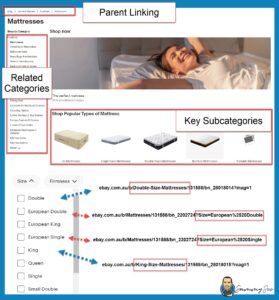Have you seen eBay’s filtering linking system?
It’s simple, effective, and one of the best-in-class internal link strategies you’ll find.
But why?
If you’re playing in the pSEO space with a portal, classified site, some sort of marketplace, and even eCom, and you’re not effectively internal linking – you’re missing out on so much SEO potential.
What’s so good about eBay’s internal linking system?
They’ve built clean & parameter URL links directly into the filters – rules and all.
Check out their mattresses page – <a href=”https://ebay.com.au/b/Mattresses/131588/bn_2202724″>https://ebay.com.au/b/Mattresses/131588/bn_2202724</a>
They have the standard breadcrumbs (parent links), related categories link (cross-linking) and key sub-category links (child linking).
What you won’t easily notice though, is they have significantly more child-links hidden within their filtering system.
Click on the ‘size’ dropdown, and then look at the links for “Double” verse “European Double”.
“Double” – A mostly clean URL of: /b/Double-Size-Mattresses/131588/bn_28018014
“European Double” – A query parameter filter URL of: /b/Mattresses/131588/bn_2202724?Size=European%2520Double
That query parameter even gets stripped in the canonical.
They are including links to both ‘clean’ and ‘ugly’ URLs in the same filtering widgets.
This isn’t something you see on many sites… if any!
You’ll get one or the other.
Every link for a filter type is clean, or every link isn’t!
The majority of sites will use JS for the filtering, and then leverage a separate linking widget in the sidebar, or below the results, to provide links to all the clean URLs.
You don’t want to link to every page that sits below, or near, the current.
Maybe it’s a filter that creates significant URLs, like pricing, for different ranges.
Or maybe it’s a super similar filter where the keywords should all rank on a single page, rather than trying to rank a super thin page.
What controls it?
Only the eBay team would know.
There could be a few different counts being involved in determining this;
- Some sort of SEO keyword opportunity or search volumes
- Popularity based on internal search
- Unique listing counts (most popular, and simplest!)
- Mix of things or SEO/product team winging it
Either way, this combination of clean and not-clean links included in a single widget offers an advanced way of ensuring you link where you want to, and only there.
You can choose the pages that get ‘created’!
Build in some scaling rules to this, and you’d even be able to auto-‘create’ new pages as you get more listings.
They’d all be cleanly linked from within the filters as the clean URLs come online.
Definitely one to investigate if you’re looking at upgrading your internal links and don’t mind spending time on something a bit more advanced.
